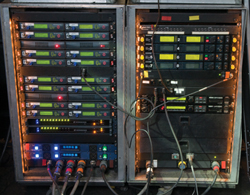
A further issue is that interfering in emergency communications (the new purpose of some of the reclaimed spectrum) could be dangerous and even life-threatening.
Digital broadcasts completely fill most 6 MHz-wide TV channels, so by now many have memorized the list in their city. (For example, I live in the Jacksonville, Florida region, and my list is 19, 24, 32, 34, 38, 42 and 44.)
If you don’t know the channels in your area, several on-line resources are available.
Scanning for optimum frequency assignment is now almost mandatory when employing multiple wireless channels in big cities.
Equipment with automatic group assignment can quickly pick the best assignment to a pre-coordinated group of frequencies. Infrared transmitter synchronizing from a receiver allows users to quickly set each transmitter to a particular receiver’s frequency – useful after automatic scanning and assignment.
Computer control and monitoring allows users to monitor audio and RF levels as well as battery status for a large number of wireless channels with a glance at a computer screen. Walk tests can be logged to determine if complete coverage exists for chosen frequencies and antenna deployments.
If your company or department makes its living providing wireless systems downtown in a big city, you’ve probably already started to rebuild your wireless department, and there may be more rentals in the future.
Users of all types are being forced to re-evaluate their wireless systems. For now, many may choose to only replace a fraction of their inventory and rent additional systems as needed.
Again, several manufacturers have rebates in effect through June 30. Place your order now and you may have your new equipment in hand by June 12. Check out these systems from each of 16 wireless manufacturers.
With change comes opportunity, and now is the time to rethink brands and models of wireless equipment.
Mark Frink is Editorial Director of Live Sound International.
